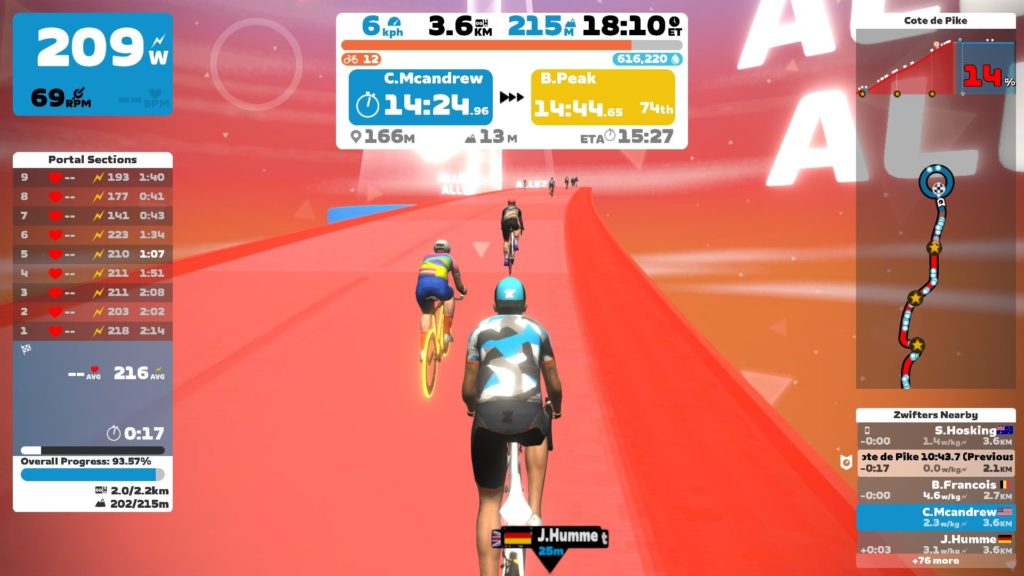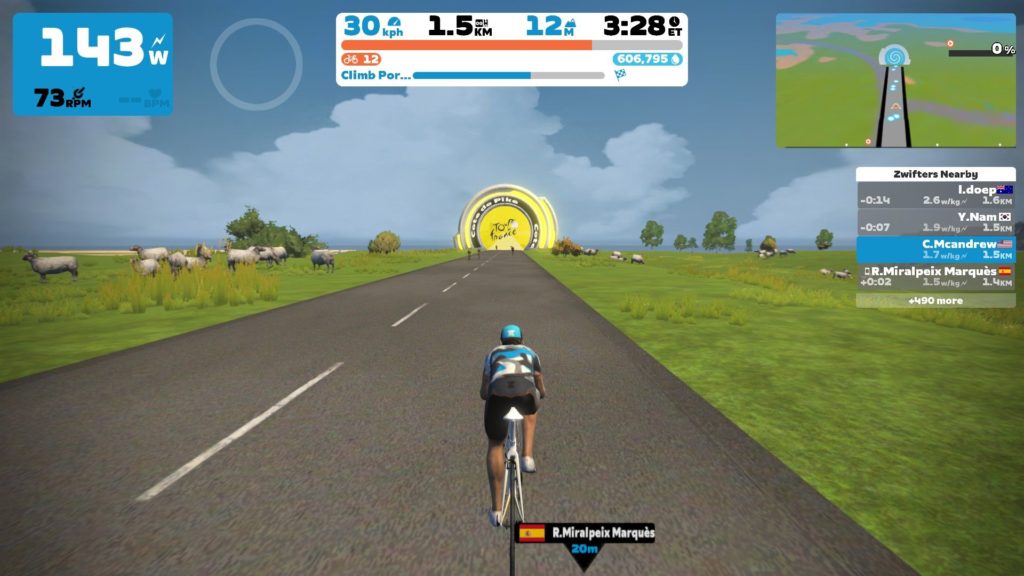If you are a Zwift fan who is getting tired of pixelated trees and powering up hills while trying to catch a glimpse of a yeti, the new Climb Portal may be of interest.
Along with other riders we got our first chance to try out the new features this week and the initial read provides plenty to be excited about.
The color scheme of Climb Portal matches that of kid like video games. Think Mario cart’s Rainbow road or an arcade style racer like the candy track from Wreck It Ralph. The road color itself is defined by the gradient underneath, a helpful visual reminder that would be useful on many other areas of Zwift where the graphics can be misleading.

Our favorite part of the climb heads up display though is the incremental sections which matches that of Alpe de Zwift (AdZ). Each climb is split into segments that are tracked as independent blocks with a timer and gradient for each.
In addition to this the section will include your power average for that section of the climb. So far the climbs we have found are broken up into 10 segments and the segments do NOT align to individual turns since some of them are on straight aways. This is different from AdZ which features segments that correspond to the switch backs of the climb.
This helpful breakdown turns the climb into a similar functionality as a pre-planned workout and makes it possible to do ad hoc intervals on various segments. What’s more the defined climb is a tracked route which means that you will get a ghost of your previous attempts on future rides. While this may not be new the addition of new courses and cycling through them on a bi-weekly basis breaks up the monotony of pedaling around the rest of Watopia.
Real Tour De France Climbs with Zwift Climb Portal
Some of the most popular competitors of Zwift focus on providing virtual attempts at real courses. Notably Rouvy is popular for having true Ironman courses GPS tracks. Zwift Portal attempts to do the same thing but this time for climbs that many fans will never have the chance to ride.
The gradient, turns, and course is designed to match that of real GOS tracks from famous climbs. By eliminating the need for graphics Zwift was likely able to pump these course out much more quickly. That’s great for their marketing which has timed it for the only major cycling event the average person knows about, th your de France and Tour de France femmes.
Thankfully this also means that Zwift has the potential to build in even more real world courses. While this Climb Portal is focused on climbs, the infrastructure exists for them to import nearly any course profile into the climb portal even if it is more of a flat course.

So far the announced courses are short, with the longest one being a 16.9 km Col du Tourmalet (with a brutal average gradient of 7.4%). Even though this is still less than the Alpe de Zwift, the total climb will still take most riders well over 45 minutes.
Entrances to each of the climbs can start from multiple points to! Our first two attempts had us riding into the same climb from the meadows and the Volcano of Watopia. This can change over time and may have just been an error. On the upside the portal can also teleport you to different climbs, so even though you may start from the Volcano, once you pass through the portal you are put on the climb that the portal states.
The Pros and Cons of Climb Portal
- Pro: New routes. The same old segments and KOMs get boring.
- Pro: Enhanced visual feedback with key metrics. Especially nice is the average Watts per segment and for the climb. As a rider with a stable weight this helps turn the climb into intervals.
- Con: Average watts seems to include more than just the climb (lead-in). This makes it less useful.
- Con: Predefined leadin. Many routes have a minimal lead in, this means if you want to warm up longer you need yo have two rides or manually turn. It would be great to be able to define a “10 minute warmup” or insert the portal at various points in your ride. Since the portal takes you to a different map some type of teleport could do this.
- Con: Limited XP. Riding the climb portal means a lot of slower uphill miles (or kilometers) with less arches and bonus points. This means you will not accrue XP quickly and so will have a slow ramp up to your Zwift Level if this is your preferred route.
- Con: No races or robopacers?!? Either of these would really step up the interactivity.
- Pro: Short segments. Unlike Alpe De Zwift these climbs are shorter with the first ones being a 8-15min effort which makes them doable even within a casual ride.
- Pro: Visual feedback from the course. Showing the elevation as a different road color is great and avoids the optical allusions of some course which feel flat and are really climbs.
How to Ride The Climb Portal FAST
Since the climb portal climbs are similar to KOMs there is motivation to try to get up them quickly or beat your last time. Generally speaking the ways to climb are going to be the same as any other standard climb, namely to choose the right bike (light weight). Beyond that there are a few Climb Portal specific tips:
- Use the lead in before the portal! As soon as you pass through the portal the time begins. That means that coming through the portal at speed will give you a momentum advantage as you start the climb.
- Power Ups should be USED. Each segment will have an arch that awards a power-up. Obviously getting a feather is the most effective power up to get up the climb, but even if you get something else be sure to burn it before the next arch and take what benefit you can.
- Warmup on the route first. If you are going for a time having an understanding of the course is a great way to figure out where your pacing should be. Not only will a warmup climb give you a ghost to pass by but it will establish PRs for each segment so you can find out how you are tracking.
- Don’t ease up on the flats. Anything blue is a low grade or even a decline. This is an area where shifting gears may be necessary to keep up the average wattage, but also is a place to pickup some momentum. Use the opportunity to keep pushing not let up as it’ll backfire.
- Know the Grades. Knowing your preferred cadence and output on different gradients helps. So what do the colors of Zwift Climb Portal equate to on steepness? The grades are broken down into:
- Blue <3% Gradient
- Yellow 3%-6%
- Orange 6%-9%
- Red 10%+
- These are the tipping points but as the road transitions from flat to a 7% grade it will visually go from blue to Orange, there is no blending of colors.
3 thoughts on “Zwift Climb Portal – What to Know”